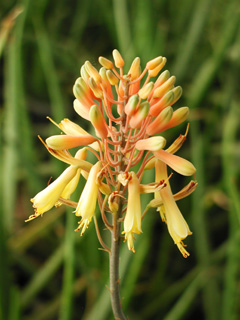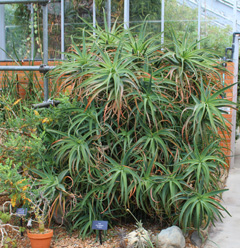 |
|
https://commons.wikimedia.org/wiki/User:Dwight_Burdette |
 |
| http://web.gccaz.edu/glendalelibrary/ |
Translate this page:
Summary
Aloe camperi.
This species from the Aloe genus is indigenous to Africa specifically the regions of Ethiopia and Eritrea, where it is considered as one of the most important medicinal plants. Aloe camperi is a perennial, succulent plant with orange flowers and rosette leaves that grow in clusters. The leaves grow up to 60 cm long and leaf base can reach up to 15 cm wide. Like other species from the Aloe genus, it is used for treating skin conditions and as a laxative. However, excess use of Aloe sap as a laxative may cause congestion and irritation of the pelvic organs. Plant exudate is known to have anti-fungal properties. Aloe camperi is also cultivated as an ornamental plant.
Physical Characteristics

 Aloe camperi is an evergreen Shrub growing to 0.8 m (2ft 7in) by 0.8 m (2ft 7in) at a medium rate.
Aloe camperi is an evergreen Shrub growing to 0.8 m (2ft 7in) by 0.8 m (2ft 7in) at a medium rate.
See above for USDA hardiness. It is hardy to UK zone 10 and is frost tender.
Suitable for: light (sandy) and medium (loamy) soils, prefers well-drained soil and can grow in nutritionally poor soil. Suitable pH: mildly acid, neutral and basic (mildly alkaline) soils. It can grow in semi-shade (light woodland) or no shade. It prefers dry soil and can tolerate drought. The plant can tolerates strong winds but not maritime exposure.
UK Hardiness Map
US Hardiness Map
Synonyms
Aloe albopicta A.Berger Aloe eru A.Berger
Plant Habitats
Edible Uses
References More on Edible Uses
Medicinal Uses
Plants For A Future can not take any responsibility for any adverse effects from the use of plants. Always seek advice from a professional before using a plant medicinally.
Antifungal Laxative Skin
This species is said to be one of the most important medicinal plants in Eritrea, although we have very ittle information on its usage. It is likely to be used in ways similar to Aloe vera, where the gel is used to treat a wide range of skin conditions and the bitters from the sap exudate is used as a laxative. The distinctive constituents in Aloe leaves are phenolic compounds, including chromone, anthraquinone or anthrone derivatives. Some of the compounds are found in many species, whereas others occur in only a few[ 299 ]. The main components of the exudate are emodin and aloenin[ 299 ]. The exudate has significant antifungal properties[ 299 ].
References More on Medicinal Uses
The Bookshop: Edible Plant Books
Our Latest books on Perennial Plants For Food Forests and Permaculture Gardens in paperback or digital formats.

Edible Tropical Plants
Food Forest Plants for Hotter Conditions: 250+ Plants For Tropical Food Forests & Permaculture Gardens.
More

Edible Temperate Plants
Plants for Your Food Forest: 500 Plants for Temperate Food Forests & Permaculture Gardens.
More

More Books
PFAF have eight books available in paperback and digital formats. Browse the shop for more information.
Shop Now
Other Uses
Other uses rating: Low (1/5). Suitable for xeriscaping. Suitable for growing in containers.
Special Uses
References More on Other Uses
Cultivation details
Plants can tolerate occasional temperatures down to around -2c, so long as conditions are fairly dry[ 423 ]. Succeeds in full sun to light shade[ 423 ]. Established plants are fairly drought tolerant[ 423 ]. Aloe species follow the Crassulacean acid metabolism (CAM). CAM plants can fix carbon dioxide at night and photosynthesize with closed stomata during the day, thus minimizing water loss. This, plus their succulent leaves and stems, and the presence of a thick cuticle, makes them well adapted to dry conditions[ 299 ].
References Carbon Farming Information and Carbon Sequestration Information
Temperature Converter
Type a value in the Celsius field to convert the value to Fahrenheit:
Fahrenheit:
The PFAF Bookshop
Plants For A Future have a number of books available in paperback and digital form. Book titles include Edible Plants, Edible Perennials, Edible Trees,Edible Shrubs, Woodland Gardening, and Temperate Food Forest Plants. Our new book is Food Forest Plants For Hotter Conditions (Tropical and Sub-Tropical).
Shop Now
Plant Propagation
Seed - we have no specific information on this species - in general Aloes are sown in a sandy, well-drained potting soil in a warm, shady position in standard seed trays. Germination takes about three weeks. Cover the seed with a thin layer of sand (1 - 2mm), keep moist. The seedlings can be planted out in individual bags or containers as soon as they are large enough to handle[ 295 ]. Suckers
Other Names
If available other names are mentioned here
Aloe
Native Range
AFRICA: Ethiopia (north)
Weed Potential
Right plant wrong place. We are currently updating this section.
Please note that a plant may be invasive in one area but may not in your area so it's worth checking.
None Known
Conservation Status
IUCN Red List of Threatened Plants Status : Endangered.

| Related Plants
|
| Latin Name | Common Name | Habit | Height | Hardiness | Growth | Soil | Shade | Moisture | Edible | Medicinal | Other |
| Aloe arborescens | Candelabra Aloe, Tree Aloe, Mountain Bush Aloe | Shrub | 3.0 |
10-11
| M | LM | SN | DM | 2 | 5 | 3 |
| Aloe ferox | Cape Aloe, Bitter Aloe, Red Aloe, Cape Aloe, Alligator Jaw Aloe | Shrub | 3.0 |
9-11
| S | LM | N | D | 2 | 5 | 3 |
| Aloe macrosiphon | Tanzanian Aloe | Perennial | 0.5 |
9-11
| S | LM | SN | D | 0 | 4 | 1 |
| Aloe maculata | Soap Aloe | Perennial | 0.6 |
8-12
| M | LMH | SN | DM | 2 | 2 | 2 |
| Aloe marlothii | Mountain Aloe | Perennial | 3.0 |
9-11
| M | LMH | N | DM | 2 | 3 | 3 |
| Aloe perryi | Perry's Aloe | Perennial | 0.3 |
10-12
| S | LM | N | D | 0 | 4 | 2 |
| Aloe vera | Aloe Vera, Barbados aloe, First Aid Plant, Medicinal Aloe | Perennial | 0.8 |
9-11
| S | LM | N | DM | 1 | 5 | 3 |
| Aquilaria malaccensis | Agar Wood, Eaglewood, Indian Aloewood, Aloeswood | Tree | 20.0 |
10-12
| S | LMH | SN | M | 1 | 3 | 3 |
| Hesperaloe funifera | New Mexico false yucca | Perennial | 1.8 |
6-9
| S | LM | N | DM | 0 | 0 | 2 |
| Hesperaloe nocturna | | Perennial | 1.8 |
6-9
| S | LM | N | DM | 0 | 0 | 2 |
| Yucca aloifolia | Spanish Bayonet, Aloe yucca, Dagger Plant, Yucca, Spanish Bayonet | Tree | 7.5 |
8-10
| S | LMH | SN | DM | 3 | 1 | 2 |
|
Growth: S = slow M = medium F = fast. Soil: L = light (sandy) M = medium H = heavy (clay). pH: A = acid N = neutral B = basic (alkaline). Shade: F = full shade S = semi-shade N = no shade. Moisture: D = dry M = Moist We = wet Wa = water.
Now available:
Food Forest Plants for Mediterranean Conditions
350+ Perennial Plants For Mediterranean and Drier Food Forests and Permaculture Gardens.
[Paperback and eBook]
This is the third in Plants For A Future's series of plant guides for food forests tailored to
specific climate zones. Following volumes on temperate and tropical ecosystems, this book focuses
on species suited to Mediterranean conditions—regions with hot, dry summers and cool, wet winters,
often facing the added challenge of climate change.
Read More
Expert comment
Author
Schweinf.
Botanical References
1
Links / References
For a list of references used on this page please go here
A special thanks to Ken Fern for some of the information used on this page.
Readers comment
| Add a comment |
|
If you have important information about this plant that may help other users please add a comment or link below. Only comments or links that are felt to be directly relevant to a plant will be included. If you think a comment/link or information contained on this page is inaccurate or misleading we would welcome your feedback at [email protected]. If you have questions about a plant please use the Forum on this website as we do not have the resources to answer questions ourselves.
* Please note: the comments by website users are not necessarily those held by PFAF and may give misleading or inaccurate information.
To leave a comment please Register or login here All comments need to be approved so will not appear immediately.
|
|